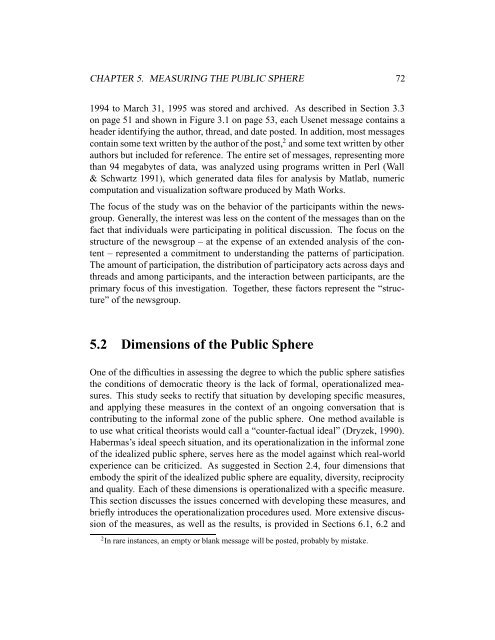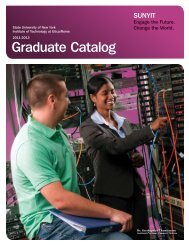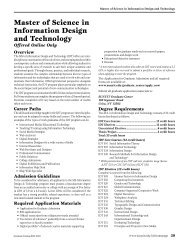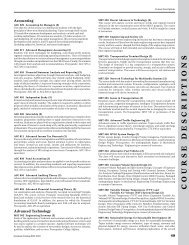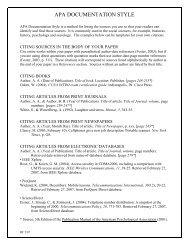Expanding the Public Sphere through Computer ... - ResearchGate
Expanding the Public Sphere through Computer ... - ResearchGate
Expanding the Public Sphere through Computer ... - ResearchGate
Create successful ePaper yourself
Turn your PDF publications into a flip-book with our unique Google optimized e-Paper software.
CHAPTER 5. MEASURING THE PUBLIC SPHERE 72<br />
1994 to March 31, 1995 was stored and archived. As described in Section 3.3<br />
on page 51 and shown in Figure 3.1 on page 53, each Usenet message contains a<br />
header identifying <strong>the</strong> author, thread, and date posted. In addition, most messages<br />
contain some text written by <strong>the</strong> author of <strong>the</strong> post, 2 and some text written by o<strong>the</strong>r<br />
authors but included for reference. The entire set of messages, representing more<br />
than 94 megabytes of data, was analyzed using programs written in Perl (Wall<br />
& Schwartz 1991), which generated data files for analysis by Matlab, numeric<br />
computation and visualization software produced by Math Works.<br />
The focus of <strong>the</strong> study was on <strong>the</strong> behavior of <strong>the</strong> participants within <strong>the</strong> newsgroup.<br />
Generally, <strong>the</strong> interest was less on <strong>the</strong> content of <strong>the</strong> messages than on <strong>the</strong><br />
fact that individuals were participating in political discussion. The focus on <strong>the</strong><br />
structure of <strong>the</strong> newsgroup – at <strong>the</strong> expense of an extended analysis of <strong>the</strong> content<br />
– represented a commitment to understanding <strong>the</strong> patterns of participation.<br />
The amount of participation, <strong>the</strong> distribution of participatory acts across days and<br />
threads and among participants, and <strong>the</strong> interaction between participants, are <strong>the</strong><br />
primary focus of this investigation. Toge<strong>the</strong>r, <strong>the</strong>se factors represent <strong>the</strong> “structure”<br />
of <strong>the</strong> newsgroup.<br />
5.2 Dimensions of <strong>the</strong> <strong>Public</strong> <strong>Sphere</strong><br />
One of <strong>the</strong> difficulties in assessing <strong>the</strong> degree to which <strong>the</strong> public sphere satisfies<br />
<strong>the</strong> conditions of democratic <strong>the</strong>ory is <strong>the</strong> lack of formal, operationalized measures.<br />
This study seeks to rectify that situation by developing specific measures,<br />
and applying <strong>the</strong>se measures in <strong>the</strong> context of an ongoing conversation that is<br />
contributing to <strong>the</strong> informal zone of <strong>the</strong> public sphere. One method available is<br />
to use what critical <strong>the</strong>orists would call a “counter-factual ideal” (Dryzek, 1990).<br />
Habermas’s ideal speech situation, and its operationalization in <strong>the</strong> informal zone<br />
of <strong>the</strong> idealized public sphere, serves here as <strong>the</strong> model against which real-world<br />
experience can be criticized. As suggested in Section 2.4, four dimensions that<br />
embody <strong>the</strong> spirit of <strong>the</strong> idealized public sphere are equality, diversity, reciprocity<br />
and quality. Each of <strong>the</strong>se dimensions is operationalized with a specific measure.<br />
This section discusses <strong>the</strong> issues concerned with developing <strong>the</strong>se measures, and<br />
briefly introduces <strong>the</strong> operationalization procedures used. More extensive discussion<br />
of <strong>the</strong> measures, as well as <strong>the</strong> results, is provided in Sections 6.1, 6.2 and<br />
2 In rare instances, an empty or blank message will be posted, probably by mistake.


